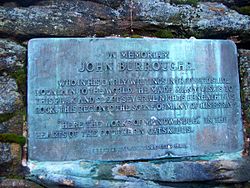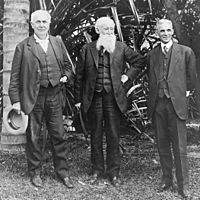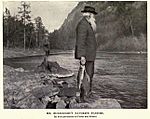John Burroughs facts for kids
John Burroughs (born April 3, 1837 – died March 29, 1921) was a famous American writer. He loved nature and wrote many essays about it. He was also part of the conservation movement in the U.S., which works to protect nature. His first collection of essays was called Wake-Robin, published in 1871.
John Burroughs was known as a "literary naturalist." This means he wasn't just a scientist studying nature. He wrote about his own special feelings and observations of the natural world. His writings were very popular during his time.
Contents
Growing Up and Family Life
John Burroughs was the seventh of ten children. He was born on his family's farm in the Catskill Mountains in Delaware County, New York. As a boy, he spent many hours exploring the mountains, like Old Clump Mountain and Slide Mountain. He loved watching birds return each spring. He also enjoyed observing frogs and bumblebees around the farm. He later said that growing up on a farm made him love nature so much.
When he was a teenager, John really wanted to learn more. His father thought the local school was enough. He would not give John money for books or more schooling. So, at age 17, John left home to earn money. He taught at a school in Olive, New York to pay for his college studies.
From 1854 to 1856, John taught and studied at places like Cooperstown Seminary. He kept teaching until 1863. In 1857, he married Ursula North (1836–1917). He had left a teaching job in Illinois to be closer to her.
John Burroughs's Writing Career
John Burroughs got his first big chance as a writer in 1860. A new magazine called Atlantic Monthly accepted his essay Expression. The editor, James Russell Lowell, thought it was so good that he first thought it was written by another famous writer, Ralph Waldo Emerson!
In 1864, John started working as a clerk for the U.S. government. He later became a federal bank examiner. He kept this job into the 1880s. All this time, he continued to write and publish essays. He also became very interested in the poetry of Walt Whitman. John met Whitman in Washington, D.C., in 1863. They became very close friends.
Walt Whitman encouraged John to write more about nature. He also helped him with his philosophical and literary essays. In 1867, John published Notes on Walt Whitman as Poet and Person. This was the first book about Whitman's life and work. Whitman himself helped edit the book before it was published. Four years later, John's first collection of nature essays, Wake-Robin, came out.

In 1873, John left Washington and moved to New York. The next year, he bought a 9-acre farm in West Park, New York. He built his home there, which he called Riverby. He grew different crops, but later focused on table grapes. He kept writing and working as a bank examiner for several more years.
In 1895, John bought more land near Riverby. He and his son Julian built a cabin there. It was built in the Adirondack style and he named it "Slabsides". At Slabsides, he wrote, grew celery, and welcomed visitors. Students from nearby Vassar College often came to see him. After 1900, John fixed up an old farmhouse near where he was born. He called it "Woodchuck Lodge." This became his summer home until he died.
In his later years, John Burroughs spent time with many famous people. These included President Theodore Roosevelt, naturalist John Muir, and inventors Henry Ford and Thomas Edison. Henry Ford even gave him one of the first cars in the Hudson Valley. In 1899, John went on an expedition to Alaska.
Henry Ford once said that he, John Burroughs, Thomas Edison, and Harvey Firestone went on many "vagabond trips" together. They traveled in cars and slept in tents. They explored places like the Adirondacks and the Alleghenies.
In 1901, John met Clara Barrus (1864–1931), who admired his work. She was a doctor. Clara was much younger than John, but she became very important to him. She later helped manage his writings after he died. After John's wife Ursula passed away in 1917, Clara moved into his house. She wrote a book in 1931 about John's friendship with Walt Whitman.
John Burroughs's Writings
Many of John Burroughs's essays first appeared in popular magazines. He is most famous for writing about birds, flowers, and country scenes. But he also wrote about religion, philosophy, and other books. John strongly supported Walt Whitman and Ralph Waldo Emerson. He also wrote about Henry David Thoreau, praising some of his ideas. His writing was so good that he was chosen to be a member of the American Academy of Arts and Letters.

Some of John's essays came from trips back to his home in the Catskills. In the late 1880s, he wrote an essay called "The Heart of the Southern Catskills." In it, he described climbing Slide Mountain, the highest peak in the Catskills. From the top, he wrote: "The works of man dwindle, and the original features of the huge globe come out. Every single object or point is dwarfed; the valley of the Hudson is only a wrinkle in the earth's surface. You discover with a feeling of surprise that the great thing is the earth itself, which stretches away on every hand so far beyond your ken." The first sentence of this quote is now on a plaque at the mountain's summit. The mountains Slide, Cornell, and Wittenberg are now called the Burroughs Range.
Other essays about the Catskills told stories of fly fishing for trout. He wrote about hikes over Peekamoose Mountain and rafting down the East Branch of the Delaware River. People in the Catskills still remember him for these writings. Even though he traveled a lot and wrote about other places, he is mostly known for his Catskill stories. He also wrote about scientific ideas like natural selection. He explored big questions about life and literature. He wrote another book about Walt Whitman in 1896, four years after Whitman died.
Love for Fishing
From a young age, John Burroughs loved fly fishing. He was well-known among anglers in the Catskills. He never wrote a whole book just about fishing. However, he did write some important fishing essays. The most famous one was Speckled Trout. It appeared in the Atlantic Monthly in 1870. Later, it was published in his book In The Catskills. In Speckled Trout, John shared his fishing adventures. He celebrated the trout, streams, and lakes of the Catskills.
Death and Lasting Legacy
John Burroughs was healthy for most of his later life. But a few months before he died, his memory started to fade. He also showed other signs of old age, like a weaker heart. In February 1921, he had surgery for a chest problem. After that, his health got worse. John Burroughs died on March 29, 1921, on a train in Ohio.
He was buried in Roxbury, New York, on what would have been his 84th birthday. His grave is at the foot of a rock he played on as a child. He called it 'Boyhood Rock'. A line he wrote years before is carved on his gravestone: "I stand amid the eternal ways".
His homes, Woodchuck Lodge, Riverby, and Slabsides, are now special historical places. They are listed on the National Register of Historic Places.
Since his death, the John Burroughs Association has honored him. This group takes care of the John Burroughs Sanctuary in Esopus, New York. This is a 170-acre area around Slabsides. Each year, the association gives a medal to the author of a great book about natural history.
Thirteen schools in the U.S. are named after John Burroughs. These include elementary schools, middle schools, and high schools. Burroughs Mountain in Mount Rainier National Park is also named after him. The John Burroughs Association gives an award each year for well-written nature books.
Boy Scouts who go to Seven Ranges Scout Reservation in Ohio can earn an award named after John Burroughs. To get this award, Scouts need to know a lot about plants, rocks, minerals, astronomy, and animals. There are three levels: bronze, gold, and silver, with silver being the highest. Each level needs more knowledge.
Famous Quotes
- "The Kingdom of heaven is not a place, but a state of mind."
- "Leap, and the net will appear."
- "A man can fail many times, but he isn't a failure until he begins to blame somebody else."
John Burroughs's Books
The Complete Writings of John Burroughs has 23 books in total. The first book, Wake-Robin, came out in 1871. New books were published regularly until the last one, The Last Harvest, in 1922. The last two books, Under the Maples and The Last Harvest, were published after he died by Clara Barrus. John also wrote a book about the bird artist John James Audubon. He wrote about his camping trip to Yellowstone with President Theodore Roosevelt. He also published a book of poems called Bird and Bough.
- Notes on Walt Whitman as Poet and Person (1867)
- Wake Robin (1871)
- Winter Sunshine (1875)
- Birds and Poets (1877)
- Locusts and Wild Honey (1879)
- Pepacton (1881)
- Fresh Fields (1884)
- Signs and Seasons (1886)
- Birds and bees and other studies in nature (1896)
- Indoor Studies (1889)
- Riverby (1894)
- Whitman: A Study (1896)
- The Light of Day (1900)
- Squirrels and Other Fur-Bearers (1900)
- Songs of Nature (Editor) (1901)
- John James Audubon (1902)
- Literary Values and other Papers (1902)
- Far and Near (1904)
- Ways of Nature (1905)
- Camping and Tramping with Roosevelt (1906)
- Bird and Bough (1906)
- Afoot and Afloat (1907)
- Leaf and Tendril (1908)
- Time and Change (1912)
- The Summit of the Years (1913)
- The Breath of Life (1915)
- Under the Apple Trees (1916)
- Field and Study (1919)
- Accepting the Universe (1920)
- Under the Maples (1921)
- The Last Harvest (1922)
- My Boyhood, with a Conclusion by His Son Julian Burroughs (1922)





